Children - Terre des Hommes
Children - Terre des Hommes
Children - Terre des Hommes
You also want an ePaper? Increase the reach of your titles
YUMPU automatically turns print PDFs into web optimized ePapers that Google loves.
79<br />
Rajasthan<br />
State Overview<br />
Rajasthan, the largest state in India in terms of area, has a<br />
population of 56,507,188 56 and a total State Domestic<br />
Product (SDP) of Rs. 1,451 billion (2007-8). 57 According to<br />
the Human Development Report Rajasthan 2008, the high<br />
growth rates that were seen in the state in the 1980s and 1990s<br />
have slowed down in the new millennium primarily due to<br />
a slowing down in the primary sector, mainly agriculture. 58<br />
Agriculture is still the largest employment sector in the state,<br />
with around 80 per cent of the population living in rural areas<br />
and dependent on farming for their survival.<br />
Agriculture accounts for the largest single share in Rajasthan’s<br />
economy and was worth over Rs. 289 billion in 2006-07. 59<br />
Rajasthan’s other key sectors are manufacturing, construction,<br />
tourism and industries, such as textiles, rugs, woollen goods,<br />
vegetable oils and dyes. In the 1990s, there was a rapid increase<br />
in mining, unregistered manufacturing, communications and<br />
real estate. During the same period, there was a decrease in<br />
agriculture, forestry and registered manufacturing. 60 This<br />
fall in registered manufacturing and rise in unregistered<br />
manufacturing, along with an increase in mining and quarrying<br />
work, has been highlighted as particularly worrying in terms<br />
of the availability of quality employment in the state. 61<br />
In the face of repeated droughts, and with more agricultural<br />
land being turned over to mining and industry, many people<br />
have been forced to devise alternative adaptation strategies<br />
for survival, as agriculture is becoming increasingly difficult to<br />
depend on. The rapid growth in population in the 1980s has<br />
meant that there has been a 2 per cent growth in the workforce<br />
leaving large numbers of people in Rajasthan in dire need of<br />
jobs. Although significant stri<strong>des</strong> were made in reducing rural<br />
poverty in Rajasthan in the 1980s and 1990s—rural poverty<br />
declined from 33 per cent in 1983 to 13 per cent in 1999—this<br />
has marginally increased again during the new millennium. 62<br />
According to the Census 2001, 17.16 per cent of Rajasthan’s<br />
population are SCs and 12.56 per cent are STs. This is<br />
slightly higher than the national average of 16.2 per cent<br />
for SCs and 8.2 per cent for STs. The vast majority of the SC<br />
and ST population lives in the rural areas of Rajasthan and<br />
are traditionally dependent on agriculture for their<br />
livelihoods.<br />
The provision of education and healthcare in the rural areas has<br />
struggled to keep up with the growth in the state’s population.<br />
Whilst the population increased by 24 per cent between<br />
1997 and 2006, the number of PHCs and sub-centres only<br />
increased by 10 per cent, from 1,616 to 1,712 respectively and<br />
from 9,400 to 10,515, during the same period. This may go<br />
some way towards explaining why the state still continues to<br />
perform poorly in terms of health outcomes. 63 In 2006, the<br />
average life expectancy in Rajasthan was 61.7, which is lower<br />
than the national average of 63.2 for the same year. 64<br />
56. Census of India, 2001.<br />
57. http://statistics.rajasthan.gov.in/GSDP_NSDP_PCI.pdf.<br />
58. Human Development Report Rajasthan 2008, Prepared for the Government of Rajasthan by the Institute of Development Studies, Jaipur.<br />
59. Indiastat.com, Net State Domestic Product at Factor Cost by Industry of Origin in Rajasthan.<br />
60. Human Development Report Rajasthan 2008, Prepared for the Government of Rajasthan by the Institute of Development Studies, Jaipur.<br />
61. Ibid.<br />
62. Ibid.<br />
63. Ibid<br />
64. Ministry of Finance, Government of India, Economic Survey, 2007-08, chapter 23, pp. 29.






